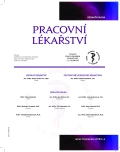Real effectiveness of respirators in protecting airways
Authors:
Š. Bernatíková 1; K. Kachlíková 2; R. Přichystalová 3; L. Kocůrková 3
Authors place of work:
VŠB-TU Ostrava, Fakulta bezpečnostního inženýrství, Laboratoř výzkumu a managementu rizik, Ostrava, vedoucí pracoviště Ing. Pavel Dobeš, Ph. D.
1; Masarykova univerzita, Správa univerzitního kampusu Bohunice, Brno, vedoucí pracoviště Ing. Pavel Brančík
2; VŠB-TU Ostrava, Fakulta bezpečnostního inženýrství, Katedra bezpečnosti práce a procesů, Ostrava, vedoucí pracoviště prof. dr. Ing. Aleš Bernatík
3
Published in the journal:
Pracov. Lék., 70, 2018, No. 3-4, s. 99-105.
Category:
Původní práce
Summary
The present work deals with testing the effectiveness of selected respirators used in the Fire Brigade of the Czech Republic (Fireman Rescue Board of the Czech Republic). The authors measured the real protecting effectiveness of respiratory recommended for the protection of airways of persons against undesirable microscopic particles averaging up to 1μm, which can enter alveoli. The respirators were tested in persons of female and male sex with different facial shapes. The protecting effectiveness of the respiratory is expressed by a total experimental factor of close-fitting (how gastight the respirator was) under conditions of dynamic physical load.
The close-fitting factor of each respirator is determined as a relation between the penetration of aerosol particles of external environment into the respirator inner space before entering respiratory organs. The concentration of aerosol particles in external environment and their penetration concentration in the respirators was measured by the PortaCount ® Pro + Model 8038 apparatus using the software for testing air-proof quality FITPRO™ under the conditions of prescribed respiration regimen, head and face movements of the tested persons.
The experimentally determined close-fitting factors were in the range of very low values 18 up to 527 (minimum value according to OSHA 29CFR1910.134 is 100). The testing of respirators proved that their protection effectiveness is principally dependent on how correctly it is put on the face, the facial shape and possibly how smooth the face surface is. The effectiveness of the closely fitting on the face also depends on their construction and size, on head movements and changes of facial expression.
Results respirator effectiveness measurements concerning particle capture made it clear that the total protecting effectiveness of respirators depends more on a correct placement of the respirator on the face than on the penetration of aerosols through the filtration material. The choice of respirators for protection of respiratory organs should be evaluated on the basis of the fitting line construction and its effective adaptation to different facial shapes. The introduction of tests on effectiveness of the correct placement of protecting devices of airways – respirators – could become a standard procedure of the employer in securing effective protection of persons against fine aerosols (size < 1 μm), which can be encountered in their professional activity.
Keywords:
respirator – aerosol – protection factor – airways
Zdroje
1. Skřehot, P., Rupová M. Nanobezpečnost. Praha: Výzkumný ústav bezpečnosti práce, 2011. ISBN 978-80-86973-89-0.
2. Hinds, W. C. Aerosol technology: properties, behavior, and mea-surement of airborne particles. 2nd ed. New York: Wiley, c1999. ISBN 978-0-471-19410-1.
3. Provozní a servisní manuál: PortaCount Pro+ 8038: Přístroje na testování respirátorů. TSI, 2009.
4. ČSN EN 149+A1. Ochranné prostředky dýchacích orgánů – Filtrační polomasky k ochraně proti částicím: Požadavky, zkoušení a značení. Praha: Český normalizační institut, 2009.
5. Slabotínský, J., Brádka, S. Reálná ochranná účinnost respirátorů. Časopis Společnosti krizové připravenosti zdravotnictví ČLS JEP, Krizová připravenost zdravotnictví, 2011, roč. 1., č. 2. ISSN 1804-9303. Dostupný na www: http://old.skpz.cz/files/Realna-ucinnost-respiratoru-Slabotinsky-suplement-2-2011.pdf.
6. Vojta, Z., Rucký E. Osobní ochranné pracovní pomůcky. 2. vyd. Ostrava: Sdružení požárního a bezpečnostního inženýrství, 2006. ISBN 80-86634-19-1.
7. Jak vybrat správný typ filtrační masky – respirátoru. In Pícha Safety s.r.o. – osobní ochranné prostředky[online]. Praha: Pícha Safety, 2018 [cit. 2018-03-18]. Dostupné na www: https://www.oopp.cz/gallery_produkty/dokumentace/0710-Y.pdf.
8. OSHA, Title 29 Code of federal Regulations, Part 1910, 134. Occupational Safety and Health Administration, 1998.
9. Kachlíková, K. Srovnání účinnosti respirátorů používaných u HZS ČR. Ostrava, 2018. Diplomová práce. Vysoká škola báňská – Technická univerzita Ostrava.
Štítky
Hygiena a epidemiológia Hyperbarická medicína Pracovné lekárstvoČlánok vyšiel v časopise
Pracovní lékařství

2018 Číslo 3-4
- Parazitičtí červi v terapii Crohnovy choroby a dalších zánětlivých autoimunitních onemocnění
- V ČR chybí specializovaná péče o pacienty s nervosvalovým onemocněním
Najčítanejšie v tomto čísle
- Skutečná účinnost respirátorů při ochraně dýchacích cest
- Poškození plic (lung squeeze) při freedivingu
- Ekzémová onemocnění rukou*
- Stanovenie rizika z expozície zamestnancov vibráciám pri práci v manipulačno-expedičných skladoch – časť 1: vedecký základ
